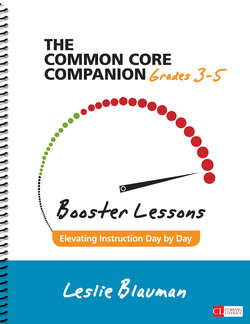Читать книгу The Common Core Companion: Booster Lessons, Grades 3-5 - Leslie Blauman - Страница 27
На сайте Литреса книга снята с продажи.
Reading a Contrasting Book
ОглавлениеAs we move into reading our second book, we refer to the anchor chart. Remember the goal here is for students to ask and answer these questions independently, to own them as readers, writers, and thinkers; so keep handing these questions off to kids whenever considering POV, so it becomes part of their DNA as they read.
Now I write on a Venn diagram “Red Riding Hood—original adaptation” on the left side and “Fractured Fairy Tale—The Wolf’s Story” on the right. I tell students that now we are going to add two more questions to our list—and these will help us to compare and contrast the new book we are about to read with the traditional version. I write:
How are the stories similar?
How are they different?
With students’ input, I record on the left side that the first book was written in third person while students articulate how they know (it said “he” and “she”). I record our thinking about who is telling the story (the narrator) and what the POV is (Wolf, evil, and Red, good.) I hold up a sticky note and tell students that we need to find an example directly from the text that supports this assertion. Students look back at the anchor chart and select an example from the beginning of the book. I write, “She was sweet and kind and liked to believe in the good in everyone.” Are there more examples we can add? I add additional evidence.
T: OK, let’s turn to the fractured fairy tale book on the same topic. Our purpose now is to answer all the questions that we have on our chart. That will help us compare and contrast these two books. We’re really going to think about how different points of view can change the meaning.
T: I’m going to read this book twice. The first time I just want you to listen to the story and enjoy it, but with one other purpose: Think about if it’s first person or third person and who is telling the story.
I read the entire book once through, then have students turn and talk with a partner to discuss if the book is first or third person, how they know, and who is telling the story. I listen in, paying attention for students who still may not understand and may need more instruction in a small group or in a conference. We discuss and record on the Venn diagram. I write “Wolf,” and tell students it’s time to listen to the story again.
T: OK, this time I want you to listen in order to figure out what the Wolf’s POV is and how you know it. Think about where in the text—which words—help you decide that? As I read, please write down evidence or an example from the book on your sticky notes. Just like we did with yesterday’s book, I’ll model first so you know what I mean.
I start reading the book again and stop to model at a point where the text supports point of view and script this on a sticky note.
T: I have to stop right here at the beginning, where the Wolf says, “Would I lie to you? It was the woman who started it. I did nothing wrong.” I’m going to jot a few of those lines on my sticky note to support what I’m thinking.
I continue reading slowly through the book, allowing students time to record their thinking. When finished, I direct them to turn and talk with partners about Wolf’s POV and how they knew that. We discuss as a group and as they share out record the POV on Venn diagram. An optional activity would be to have students add their sticky notes to the Venn as they return to their seats.
